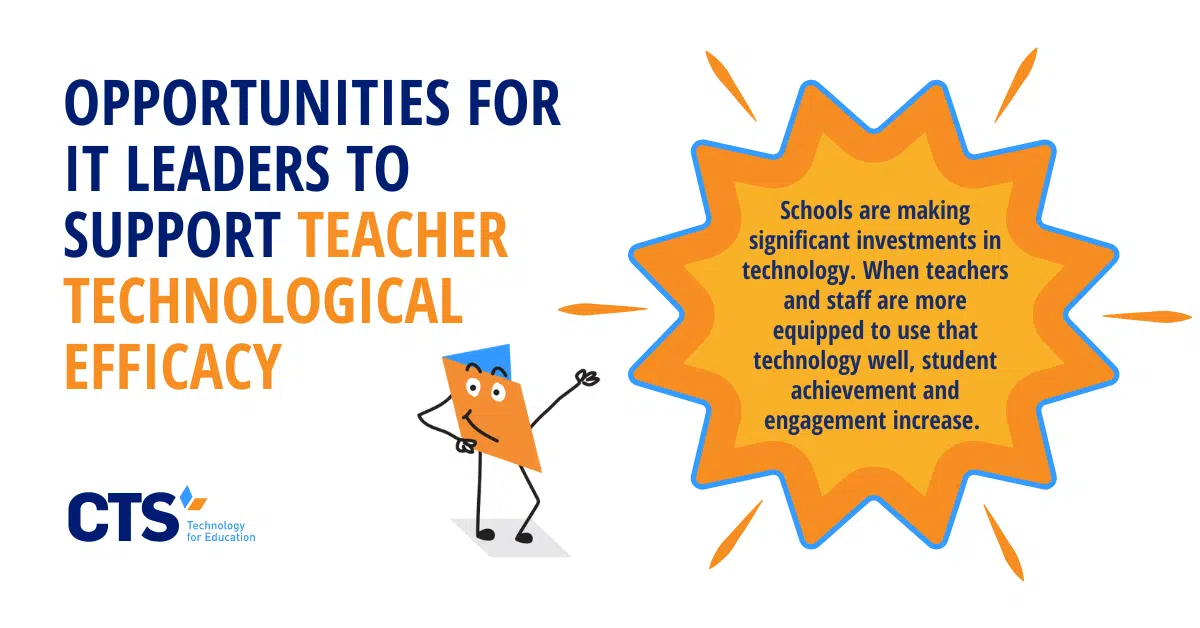Students benefit most from their school’s technology when their teachers’ technological efficacy is high.
As schools shifted to remote learning at the start of the COVID-19 pandemic, school leaders and IT administrators scrambled to get devices into the hands of their students. This shift to digital, at-home learning caused a tremendous amount of stress for school leaders and IT administrators and for students and their families. This shift also caused stress for educators – particularly the ones with lower technological efficacy. For teachers who didn’t frequently use technology in the classroom, perhaps those who were accustomed to a school with only one laptop cart per grade or a shared, mobile Promethean board, this rapid shift was dizzying.
The one-to-one device-to-student ratio that came about during the pandemic continues to persist even with schools being back to full in-person learning. Nearly 85% of the 1,000+ educators responding to a recent EdWeek Research Center survey said that their districts had enough devices to cover all students. This high-level use of technology in the classroom has required significant financial investments in hardware, software, and infrastructure. School leaders, district leaders, and IT administrators seeking a high return on these investments are in search of strategies that keep teacher technological efficacy high.
Ongoing teacher training is one way to support better technology integration.
With constant shifts in emerging technology and software options, even the most tech-savvy teachers are in need of continuous learning and development. Since interactive learning environments help students improve their digital literacy and work collaboratively, schools are seeking new tools and new ways to integrate these tools.
For example, more and more schools are using digital whiteboards to give teachers the option to show video clips alongside open browser windows while having students up at the board solving equations while other students are participating in the content of the lesson, via the board, from their devices. Teachers need support and training to be able to successfully adopt this technology. They also need advice and guidance on best practices in aligning the technology to the curriculum and selecting activities that drive learning.
Similarly, as the costs of 3D printing technology have decreased over time, more schools find themselves able to incorporate this tech into their classrooms. Design thinking skill development, increased student engagement, and more opportunities for hands-on learning are some of the many benefits of this technology. Learning how to use the actual printers is not the only learning curve for teachers. Designing 3D printing activities that are aligned with learning objectives is another space where proactive, ongoing professional development becomes critical.
Ensuring that devices are maintained and accounted for is another critical aspect of supporting a school’s technological efficacy.
After teachers have received the technical training and professional development that supports the integration of technology into the curriculum, the last thing they want or need is to arrive at school and find that the 3D printer is not working that day, that some of the devices that are connected to their shared, mobile Promethean board are missing, or that some of their student devices have been infected with malware.
To decrease the likelihood of these incidents happening, school leaders and IT administrators want to be judicious about their tech purchases to ensure that their devices are reliable and durable, in addition to being cost-effective. Having an effective system for inventory management and a process for device maintenance, repair, and anti-malware software updates will save many teachers from these frustrations.
At CTS, we support schools as they work to increase the technological efficacy of their staff while integrating emerging technology into the classroom.
In addition to all of their other instructional, cultural, and operational responsibilities, school leaders are working to find time to track trends in emerging technology and to decide which options best suit their school’s unique mission. Once leaders make the technology selection, they are tasked with ensuring that their staff has the technical understanding to use these tools and the instructional competencies to successfully integrate the tools into teaching and learning. This strand of work takes time and we know that time is an extremely limited resource for today’s school leaders. At CTS, our goal is to take the lead on sourcing, procuring, and technical training for technology so that school leaders can focus on the needs of their teachers, their students, and their school’s mission.
In addition to supporting the more commonly found hardware like laptops and digital whiteboards, we also support schools with sourcing and procurement of emerging technology like 3D printers, virtual reality, artificial intelligence, and augmented reality devices. We can handle the hardware and software purchasing and support staff with training so they can make good use of the technology in pursuit of better student engagement and increased achievement. If you are interested in learning more about the availability of emerging technology, how to best support your teachers’ technological efficacy, and how implementation can benefit your students, we can help.
At CTS, we can also help with device inventory, tracking, and management. Our clients have access to our device management platform. By putting all of a client’s devices on this platform, we ensure easy and comprehensive deployment of security updates in addition to other operational benefits like managing settings and deploying software and applications.
Contact us today to learn more about our services and how we can help your school accomplish its unique mission.




